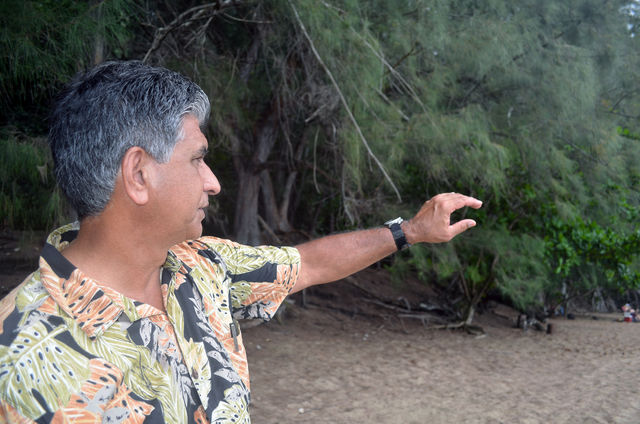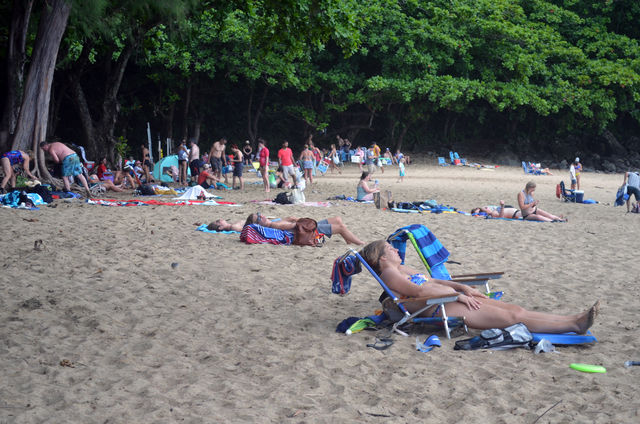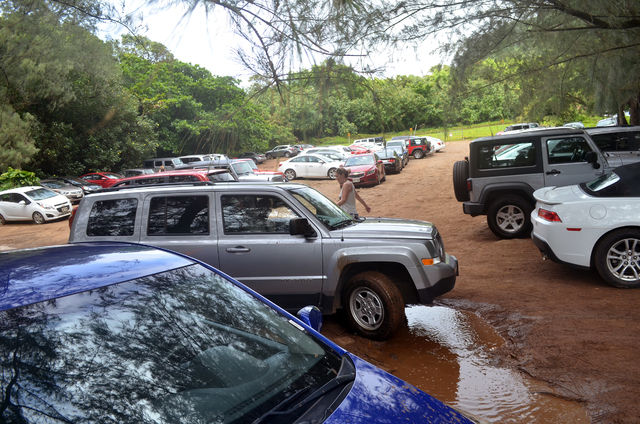HAENA — Hui Maka’ ainana o Makana volunteers have put in 6,000 hours of work a year into Haena State Park. Farmers left the Haena area in the 1950s, and overgrown trees have taken the place of the houses, blocking
HAENA — Hui Maka’ ainana o Makana volunteers have put in 6,000 hours of work a year into Haena State Park.
Farmers left the Haena area in the 1950s, and overgrown trees have taken the place of the houses, blocking the view of the ocean and overtaking the old poi mill.
To clean up the park, residents of Haena formed the nonprofit that is dedicated to restoring Hawaiian values and stewardship practices.
“One of the families down there said we need to start taking back the land,” said Presley Wann, president of Hui Maka’ainana o Makana. “It was the vision of one of our kupuna to see the ocean again.”
The group, formed in 1999, is made up of about 20 people, all of whom have ancestors who called Haena home, Wann said.
When the hui began its work, such as clearing vegetation and working on an irrigation system, it received a grant from the Office of Hawaiian Affairs to buy heavy tools, Wann said. Any essentials needed after OHA grant money ran out came out of the hui member’s pockets or fundraising.
But now, the Hawaii Tourism Authority is stepping in. It appropriated $140,000 last month to help the hui finish its projects.
Because Haena is on Department of Land and Natural Resources land, it’s ultimately up to them to make sure the area is taken care of, said George Costa, director of the Office of Economic Development.
“We’re helping them clean up the area, so we need their (financial) help,” he said.
When Costa contacted DLNR, they said they didn’t have money, and suggested he contact HTA. Last August, Fred Atkins, the Kauai representative for HTA, helped him lobby for the funding, he said.
George Szigeti, president and CEO of HTA, said he supports Kauai’s efforts to improve Ke‘e and Haena.
“(They) are two places that have become very popular with visitors to the island,” he said. “We all know how special these places are to residents, and felt it was important that we collaborate with the county to help find creative solutions that preserve the natural beauty of the area and enhance the experience for both locals and visitors.”
Costa was told June 1 that funding was secured. But they had only 30 days to finalize plans, or the money would lapse. On June 15, Costa appeared before the County Council, which unanimously voted to approve the funding.
“It’ll be nice not to worry about fundraising,” Wann said. “It’s going to expedite our vision to open up the area.”
Because some of the hui members work in construction, they are using their expertise to finish the projects on their own, Costa added.
“They work hard, but they enjoy being there,” he said.
HTA will also help fund improvements to the main parking lot at Ke’e Beach, which will be completed by the hui.
According to a report by HTA, about 1,500 vehicles come and go from the park every day. Continuous use has put strain on the parking lot. Work includes removing boulders, grading the area and positioning the slope toward the existing drainage swale, transporting rock material and compacting the parking area.
Because the project will close the parking lot for about two weeks, it won’t begin until after Labor Day, so it won’t disrupt the busy summer season, Costa said.
HTA is also funding $160,000 to bring back the North Shore Shuttle program. The OED hopes the shuttle, which may start July 15, will encourage visitors to leave their vehicles at their hotels and take the shuttle into Hanalei and Haena.
Sue Kanoho, executive director of the Kauai Visitor Bureau, said she is thankful HTA stepped up to the plate.
“I have been sharing with HTA and Hawaii Visitors and Convention Bureau the past three to four years that the area of Haena has been challenged with the number of people that use the Haena State Park on a daily basis and their respective cars, with very limited parking,” she said. “We are extremely grateful to HTA for the support they have given with this funding, to try and assist with an issue that has been growing exponentially, especially in light of social media.”




